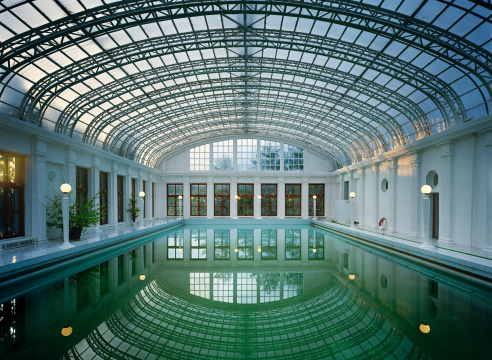
New work by acclaimed photographer Andrew Moore will be on view at Yancey Richardson from November 16, 2023, through January 6, 2024. The exhibition, Whiskey Point and Other Tales, delves into the dazzling scenes and moody vistas of the storied Hudson Valley of New York. Through his vividly colored, large-scale photographs, Andrew Moore is known for investigating the intersections of historical moments in the U.S. and abroad, documenting the natural and built landscapes in places such as Detroit, the American South, the Great Plains, New York City, Cuba, and Bosnia. Whiskey Point refers to a strip of land that juts out into the Hudson River in Ulster County where the surrounding soil was once cleared for brick production. Today it is part of a new park named after African American abolitionist and suffragette Sojourner Truth who was born a slave in Ulster County in 1797.
From the mythological tales of the Indigenous Lenape and the Norse Viking sagas to the Hudson River School painters, the Hudson Valley region possesses a magical, yet familiar attraction. Moore presents a layered approach to photography and storytelling by interweaving narrative with documentary and personal experiences with historical and generational events. The work reveals different kinds of lineages, such as how artists borrow from and remake art history.
In 2019, after 39 years of living in New York City, Moore moved his studio to Kingston, NY, in the Hudson River Valley. When the Covid pandemic hit the following year, Moore redoubled his efforts to portray his immediate surroundings. Building on the past precedent of the Hudson River School of painting, while studying the geologic structure and atmosphere particular to the region, he set out to explore the weather, tides, and landscapes of the Hudson Valley. It was far from a solitary pursuit as he met hundreds of people as part of his image-making process. He also left notes in mailboxes of homeowners who welcomed his request to photograph their homes.
“I went back to nature and slowly my pandemic project became about taking stock, working closer to home, exploring and returning to something simpler, yet at the same time seeing the layers of history, the work of the Hudson River School painters, and the intersection of photography and painting,” Moore notes. “This place is not really a place but an event, a location unfolding in time, narrating its own story. The photographs embrace how the natural world improvises on its own themes, how the human world is more than a little wild, and how the two are inseparable.”
A touchstone for Moore was the photography and paintings of his great-great-grandfather, the 19th century American artist Alfred A. Hart (1816-1908). Hart was the official photographer for the western half of the Central Pacific Railroad, the U.S.’s first transcontinental railroad. In addition to continuing his family’s visual pursuits, Moore was also greatly inspired by the paintings of Hudson River School artists, including Asher Brown Durand (1796-1886), Thomas Cole (1801- 1848), Frederic Edwin Church (1826-1900) and Susie M. Barstow (1836-1923).
“I slowly started focusing on the wide views of the Hudson Valley in different seasons, reinterpreting the Valley using new tools. With the ability of digital photography to layer, combine and recompose images, I could incorporate aspects of Hudson River School painting, merging light and subjects in an homage to the painters who would traditionally blend their sketches,” Moore explains.
During one of his expeditions, Moore came across another photographer standing with a camera on a tripod in front of a magnificent view of the Hudson River and Whiskey Point. The scene could not have been better composed if Moore had directed it himself – a modern-day model of a Hudson River School painting directly in front of him. For Moore, that one moment summed up the work of generations of artists who have elegantly captured the layers of history and beauty in the region.
American photographer Andrew Moore (born 1957, Connecticut) is widely acclaimed for his photographic series, which record the effect of time on the natural and built landscape. From 2001-2010, he was a visiting lecturer at Princeton University. Since 2004 he has taught in the MFA photography program at the School of Visual Arts in New York. Numerous prominent institutions have held solo exhibitions of Moore’s work, including the Queens Museum of Art, New York; Akron Art Museum; Grand Rapids Art Museum; Colby College Museum of Art, Waterville, Maine; and the National Building Museum, Washington D.C. He has received grants from the John Simon Guggenheim Memorial Foundation, National Endowment for the Humanities, New York State Council on the Arts, J.M. Kaplan Fund, and Cissy Patterson Foundation.
Moore’s work is represented in numerous public collections in the United States and internationally, including the Metropolitan Museum of Art, New York; Whitney Museum of American Art, New York; J. Paul Getty Museum, Los Angeles; Library of Congress, Washington, D.C.; San Francisco Museum of Modern Art; Los Angeles County Museum of Art; Yale University Art Gallery; and the Detroit Institute of Art. Numerous monographs of his work have been published: Inside Havana (2002, Chronicle); Russia (2005, Chronicle); Detroit Disassembled (2010, Damiani); Andrew Moore: Cuba (2012, Damiani); Dirt Meridian (2015, Damiani) and Blue Alabama (2019, Damiani). Moore produced and photographed How to Draw a Bunny, a documentary feature on the artist Ray Johnson. The film premiered at the 2002 Sundance Festival, where it won a Special Jury prize. He lives and works in Kingston, NY.